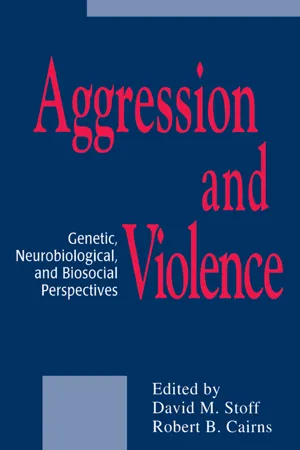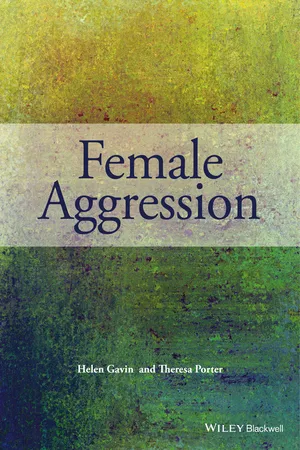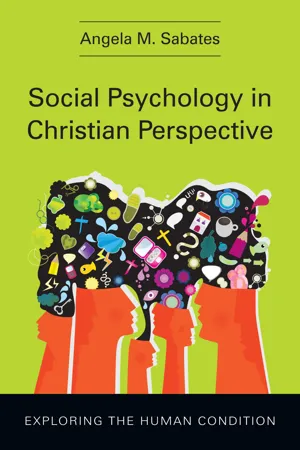Psychology
Gender and Aggression
Gender and aggression refer to the study of how gender influences aggressive behavior. Research suggests that males tend to display more physical aggression, while females may exhibit more relational aggression. Biological, social, and cultural factors all play a role in shaping gender differences in aggression. Understanding these dynamics can help inform interventions and strategies for managing aggressive behavior.
Written by Perlego with AI-assistance
Related key terms
11 Key excerpts on "Gender and Aggression"
- eBook - ePub
Sex Differences in Social Behavior
A Social-role interpretation
- Alice H. Eagly(Author)
- 2013(Publication Date)
- Psychology Press(Publisher)
Related to these concerns about the limited social contexts of social psychological aggression research are the questions that a number of scholars have raised about the construct validity of the findings generated by the popular laboratory research paradigms. This meta-analysis included in its sample of studies nearly all studies that researchers regarded as investigating adult aggression (provided that these studies also met criteria for an interpretable sex difference, see the Method section). As other commentators have pointed out (Bertilson, 1983; Geen, 1976; Rajecki, 1983), there is little internal evidence in most such studies that the dependent measure is primarily an aggressive behavior motivated by the harmful intent central to most social psychological definitions of aggression (e.g., Baron, 1977; Berkowitz, 1964). For example, an ostensibly aggressive behavior may reflect demand characteristics of the experiment (Schuck & Pisor, 1974) or the perpetrator's desire to either help the target person (Baron & Eggleston, 1972) or reciprocate a hostile action (Tedeschi, 1983; Tedeschi, Smith, & Brown, 1974). Although the validity of laboratory aggression research has been defended (e.g., Berkowitz & Donnerstein, 1982), for the most part these important issues remain unresolved. Moreover, as shown by dictionary definitions of aggression, nonpsychologists consider that aggression encompasses forceful actions intended to dominate or master, regardless of their harmful intent. The resulting discrepancy between popular and social psychological definitions of aggression also suggests caution in generalizing from this meta-analysis to conclusions about sex differences in the broad range of behaviors ordinarily considered aggressive.Social Roles and the Prediction of Sex Differences in Aggression
Generally compatible with the social-role analysis are the findings that sex differences in aggression are relatively small when averaged and quite inconsistent across studies. Recall, for example, that the male gender role, although more supportive of aggressiveness than the female gender role, was regarded as discouraging aggressiveness under certain circumstances. Because of such complexities of normative regulation of aggression, considerable variability in the magnitude of sex differences in aggression would be expected, along with a relatively small mean difference. As in the case of helping behaviors (Chapter 2 ), this relatively small mean was created by averaging heterogeneous effects, some of which are quite large. Given these results, mean effect sizes implying a sex difference of a certain magnitude are less important than successful prediction of variability in the effect sizes.The social-role analysis proved moderately successful in suggesting specific predictors of sex differences in aggression. With respect to the categorical study attributes, the strongest predictor was whether aggression caused physical or psychological harm to its target. Thus, supporting the analysis, the tendency for men to aggress more than women was more pronounced when the situation provided an opportunity for physical rather than psychological aggression. Reinisch and Sanders (1986) have reported similar findings in a study of college students’ retrospective reports of how they coped with conflict situations at age 13: Males reported more physical aggression than females but did not differ from females on verbal aggression (e.g., calling one's opponent a bad name or yelling at one's opponent). However, in the meta-analysis the sex difference in psychological aggression (similar to Reinisch and Sanders's verbal aggression) remained significant (see Table 3.3 - eBook - ePub
Aggression and Violence
Genetic, Neurobiological, and Biosocial Perspectives
- David M. Stoff, Robert B. Cairns(Authors)
- 2014(Publication Date)
- Psychology Press(Publisher)
To join in this debate, the present discussion offers a brief review of studies in women’s aggressive development, which serves as a prelude to considering genes, hormones, puberty, menstrual cycle effects, and socialization. The focus is on studies using direct behavior observation. Questions about sex and biological causation are put into comparative perspective because nonhuman animals presumably are not influenced by social-psychological factors related to gender roles, and because animals can be used in powerful experimental designs. Applying the same or similar questions and methods of study to different species can provide a test of the generality of findings, and a source of new hypotheses. Ultimately, girls’ development is the focus: What happens to girls’ aggressive behavior during the course of maturation and anticipatory socialization for adult roles? The concluding section assesses the significance of these findings for supporting aggressive or assertive behavior as a component of girls’ and women’s healthy development. Gender-specific developmental pathways leading to problematic outcomes such as violence or depression are considered with a view to clinical interventions that might prevent or ameliorate problems in development.The perspective is an optimistic one because it is set in the present era of social transformation, as women by their own efforts are entering public positions of authority. Women scientists and practitioners can disclose, define, and interpret for themselves the dialectic of sex and gender, and the actual or potential significance of women’s aggressive behavior.Sex and Gender Differences in Aggressive Behavior
A pervasive assumption in the study of aggressive behavior has been that males have an appetite for aggressive encounters with same-sex conspecifics, whereas females fight only to protect offspring (Moyer, 1976 ). Moreover, the apparent prevalence of sex differences implies that the sources are fixed biological factors, according to Maccoby and Jacklin (1974 , 1980) . Even in experimental social psychology (Frodi, Macaulay, & Thome, 1977 ), biological factors are invoked to “lay the groundwork for an understanding of the phenotypic expression of whatever genetic differences may exist.” However, higher levels of male aggressiveness are not found in 44 of the 72 studies reviewed in that work (Frodi et al., 1977 ). The findings indicate that women are equally likely as men to report feelings of aggressiveness or hostility (also see Werner & Smith, 1992 ). These feelings are manifested as aggressive behavior only when the situation is seen as justifying an aggressive response. If subjects are provoked or angered, or if subjects are assured anonymity, then women are equally as aggressive as men (Frodi et al., 1977 ). Otherwise, self-reported anxiety and guilt stops women from acting on their angry feelings.Fear of retaliation also stops women’s aggression. From a meta-analysis of 81 findings from 63 studies, Eagly and Steffen (1986) conclude that gender differences in aggressive behavior arise from women’s and girls’ expectation of punishment for aggressive acts. In these meta-analyses and in the meta-analyses of 143 studies using nonclinical samples by Hyde (1984 , 1986) - eBook - ePub
- Helen Gavin, Theresa Porter(Authors)
- 2014(Publication Date)
- Wiley-Blackwell(Publisher)
This lack of definitional clarity is possibly due to the range of theoretical positions underlying all of the research in aggression. This range can be loosely defined as psychological theories (from psychodynamic positions to cognitive and behavioural models to social origins of behaviour, and societal factors inherent in aggression) and biological perspectives (including evolutionary theories, genetic causes, chemical contributions and neurological outcomes). This chapter introduces these positions and relates them to the study of female aggression.Aggression and Women
It is accepted that men are more likely to express their aggression in ways that are physically violent, and that women will behave in indirect ways, being less capable of exerting the same physical force. This somewhat simplistic viewpoint is reflected in every major theoretical perspective on aggression; comparative, evolutionary, biological, psychological and social models all reiterate that men/males are the aggressors. Women are viewed as only using aggression in passive, submissive or emotional ways. This book sets out to examine this position and to explore theories and research about female aggression, its motives and outcomes, possibly exposing a few myths on the way.Physical aggression among and by girls and women has become more prevalent. This is evident in women's sports, media aimed at or including women, and the criminal and juvenile justice systems (e.g., UK Home Office, 2012; US Bureau of Justice Statistics, 2014). Psychological theories provide a basis for examining a society that values aggression and the consequences of that (erroneous) placement of worth. If society that accepts male aggression and violence becomes accepting of female aggression, then rising rates of female-perpetrated violence must be the consequence. Conversely, women's violence and aggression may be leaving the domestic sphere, where it has been relatively invisible, and entering the public arena.Female aggression is a fact of life, but one that is only lately being addressed by mainstream social and behavioural sciences. There is a wealth of animal research that examines female aggression, but applying these findings to human behaviour or emotional response is difficult at best. Studies on rodents, or red-fronted lemurs, or even our genetically closest primates concentrate on female aggression as the result of events that concern animals, such as competition for mates or food, or the protection of offspring. Such research must also be careful to curtail any interpretation that could open itself to criticism of anthropomorphizing behaviour. When we do find aggression studies on humans, it is almost as if the peculiar lens of comparative psychology must be applied here, as researchers seem happy to compare female behaviour to that exhibited in the male, rather than as behaviour in its own right. The literature on the topic seems to view aggression by women or girls as either a pale copy of male aggression, or specific to certain situations, such as alcohol abuse or domestic violence. There is also a tacit assumption that female aggression has the same motivations and form of expression as male aggression. There is little acknowledgement in the literature that viewing female aggression as poorly expressed imitative behaviour of male aggression minimizes and trivializes women's behaviour, anger, perspectives and viewpoints. In 2005, Richardson reviewed thirty years of research on gender differences in aggressive behaviour. She found that the assumption that females were not aggressive could not be supported, as studies did, in effect, demonstrate the opposite. Women in laboratory studies did respond to provocation and could not be described as passive. The conclusion is that the major point of difference is not in the form of aggression, but the relationship between aggressors, or aggressor and victim. - eBook - ePub
Getting Grounded in Social Psychology
The Essential Literature for Beginning Researchers
- Todd D. Nelson(Author)
- 2017(Publication Date)
- Psychology Press(Publisher)
Although gender as such does not carry any explanatory power, it may be seen as a marker for underlying psychological processes that distinguish between men and women. One such process is the socializing effect of gender role prescriptions that designate aggression as less acceptable for women than for men. In line with this explanation, a meta-analysis by Bettencourt and Miller (1996) revealed substantially greater gender differences in unprovoked, proactive aggression than in reactive, retaliative aggression, which is less at odds with female gender norms. From an evolutionary perspective, aggressive behavior is seen as more adaptive for men than for women in securing the survival of the gene pool (Archer, 2009). The finding that gender differences in physical aggression are found across cultures is quoted as support for the evolutionary explanation. Both cultural and evolutionary explanations can be fruitfully combined to explain gender differences in social behavior, including aggression, as exemplified by the biosocial model of gender differences proposed by Wood and Eagly (2012).The variables discussed in this section illustrate how differences observed between individuals in the frequency and form of aggressive behavior may be explained by stable personality characteristics. A full discussion of this literature is beyond the scope of this chapter. A range of additional constructs, including trait hostility and trait anger, rumination, irritability, and hostile attributional style, have been associated with individual differences in aggressive behavior, as reviewed in Krahé (2013a).Why Are Some Situations More Likely to Elicit Aggression Than Others Are?
The present section will present some answers to this question by reviewing research on four contextual or situational variables: social exclusion, high temperatures, alcohol consumption, and exposure to violence in the media.Social Exclusion
eing liked and accepted by others is a basic human need, which is why the experience of social rejection and exclusion is linked to intense negative affect. Negative affect, in turn, is a key instigator of aggressive behavior, as conceptualized by several of the theories reviewed earlier. Social exclusion, also referred to as “ostracism,” has been measured in the lab in different ways. One common method is the so-called “Cyberball” paradigm, in which avatars toss a ball between them on a computer screen (Williams, 1997). Research participants are instructed to imagine being one of the players and then find their avatar to be either systematically excluded or included in the ball-tossing rounds. A second method is the so-called “Get Acquainted” paradigm, in which participants first meet a number of people in a brief group session and are then informed that none of the other group members had chosen them as a partner to work with on the experimental task (Leary, Tambor, Terdal, & Downs, 1995). Social exclusion was found to activate the same brain regions and elicit similar psychological responses as the experience of physical pain, demonstrating its profound negative impact (Eisenberger, Lieberman, & Williams, 2003; Riva, Wirth, & Williams, 2011). - eBook - ePub
- John Archer(Author)
- 2022(Publication Date)
- Routledge(Publisher)
male violence will be a controversial choice in the eyes of some readers. I shall therefore seek to justify this emphasis. I shall also consider who are the victims of male violence, and finally discuss the connection between sexual and aggressive motives for sexual aggression.VIOLENCE AND AGGRESSION
Throughout this book, the reader will encounter both the terms ‘violence’ and ‘aggression’. We are particularly concerned with violence, although in order to consider the background to violent acts we also have to consider the broader category of behaviour which psychologists and behavioural biologists refer to as ‘aggression’. In many instances, these terms have been conflated. For example, Gerbner (1974) , in a study of television violence, defined violence as ‘the overt expression of physical force’, a phrase which could equally well have applied to ‘physical aggression’. In a later study of the same subject, Williams, Zabrack and Joy (1982) qualified this definition, referring to violence as ‘physically aggressive behaviors that do, or potentially could, cause injury or death’ (p. 366). This added emphasis on the damage caused is, in my opinion, the crucial distinction between physical aggression and violence. The first concentrates on the act and the second on the consequences.This distinction has not been clearly drawn in a number of areas of aggression research. One area where it is particularly important to do so is the study of aggression and violence in sexual relationships, notably between marriage partners. As indicated in the next section, this lack of clarity has contributed to very different interpretations based on studies emphasizing either behavioural acts or their consequences. - eBook - ePub
- Miles Hewstone, Wolfgang Stroebe(Authors)
- 2021(Publication Date)
- BPS Blackwell(Publisher)
Studies using frequency counts of aggressive acts that ignore the context in which they take place show that men and women are equally likely to show aggressive behaviour against a partner. By contrast, crime statistics and studies taking context and consequences of aggressive acts into account show that men dominate as perpetrators and women as victims of intimate partner violence. How common is sexual aggression and what are the psychological consequences? Sexual violence is committed mostly by men against women, even though some studies have documented same‐sex sexual aggression and women’s sexual aggression towards men. In the majority of cases the assailant is someone previously known to the victim. The consequences of sexual victimization are severe, including negative reactions from others. What is bullying and how harmful is it? School and workplace bullying are forms of aggressive behaviour characterized by an imbalance of power between aggressor and victim, and often take place over extended periods of time. Cyberbullying is a new form of harassment using electronic devices that makes it easy for perpetrators to bully others under the cloak of anonymity. What are the processes triggering aggression between groups? Intergroup aggression occurs not only as a result of conflicts between groups over material resources, but also as a result of changes in self‐focused attention and social identity concerns. The staircase model of terrorism illustrates the interplay between social conditions of injustice and individual characteristics in explaining why people commit terrorist acts. How can aggressive behaviour be prevented or reduced? The popular notion of catharsis has been disconfirmed as a strategy for reducing aggression. Punishment may be effective if imposed swiftly, but it conveys the message that aggression is an accepted means of conflict resolution - Paula J Caplan(Author)
- 2015(Publication Date)
- Psychology Press(Publisher)
Measures of relational and indirect aggression are susceptible to the same kinds of measurement problems as so-called direct aggression. Namely, ratings of aggressive behavior of all kinds are done by subjective raters, either researchers, peers, or teachers or by self-report. In all cases, the raters likely have expectations about sex differences (or lack of sex differences) that could influence their ratings in unknown ways, and the size of the sex difference (effect size) can change drastically depending on who is doing the rating (Hyde, 2005). In sum, studies are extremely variable in terms of whether they yield a sex difference in one direction or another, and at the very least, they depend greatly on age (Archer & Coyne, 2005). While the notion of relational or indirect aggression as a predominantly female form of aggression may resonate with our cultural expectations of women versus men, there is little reliable support for this notion; in fact, relational aggression is one area that seems to be remarkably similar between sexes (Hyde, 2005).Some Social and Political Consequences of Assumptions About AggressionAccording to most traditional theories of personality, males have more powerful, less controllable aggressive and sexual drives than do women. It is rather demeaning to men to assume that they cannot control, or take responsibility for, their urges and impulses, but the demeaning implications have usually been overlooked. Indeed, if it were really true that men were innately and unavoidably powerless to control their aggressive and sexual drives, then one would think that society would have developed ways to impose some control; for instance, men might have been forbidden to appear on the streets after dark or might have been kept out of powerful jobs where their urges might cause serious harm.Instead, the claim that males’ drives are innately stronger and less controllable has often been used to justify men’s imposition of their sexual and nonsexual aggression on others and to blame their victims—who are usually women or children—for “bringing it on themselves,” allegedly by “nagging,” being “seductive,” or both.Other clinicians, researchers, and theorists (e.g., Dutton & Painter, 1981; NiCarthy, 1982; Rush, 1980; Russell, 1982, 1984, 1986; L. Walker, 1979; Caplan, 2005) have made it clear that men’s—like women’s—treatment of other people is their responsibility, and it is neither accurate nor fair nor healthy to claim otherwise. Some points that should have been obvious but that were obscured by male-excusing theories have also come to light; for instance, if men really had no control over their aggressive impulses, and males were innately more aggressive than females, all men would inflict violence on their wives and children, and once a man started to beat his wife, he would continue until he killed her (which happens occasionally but not always). Recent work has shown that female and child victims do not bring the violence on themselves, certainly do not enjoy it, and in fact often find ingenious ways to survive and resist as much as they can in the face of terror (Caplan, 2005; NiCarthy, 1982; Russell, 1982, 1984, 1986; B. Walker, 1985; see also Chapter 10- eBook - ePub
- Miles Hewstone, Wolfgang Stroebe, Klaus Jonas(Authors)
- 2016(Publication Date)
- BPS Blackwell(Publisher)
The research reviewed in this section shows that aggressive behaviour varies both as a function of person variables and as a function of situational context. Stable individual differences in the propensity to act aggressively (trait aggressiveness) and to interpret others’ actions as an expression of hostile intent (hostile attribution bias) predict differences in the ease with which aggressive responses are triggered in a particular situation. Research has also identified gender differences, with men showing more physical aggression than do women. So far, the evidence is less clear-cut for indirect aggression, such as spreading rumours. Among the situational variables affecting the likelihood of aggressive behaviour, research has consistently shown that alcohol consumption, high temperature and exposure to media violence lower the threshold for aggressive behaviour. In the case of media violence, longitudinal studies have demonstrated that negative effects can be found over extended periods of time.AGGRESSION AS A SOCIAL PROBLEM
What do we know about the prevalence and the risk factors of intimate partner violence, sexual aggression, bullying and violence between groups?
The theoretical and empirical contributions discussed so far identified critical input variables as well as cognitive, affective and arousal processes that explain the occurrence of aggressive behaviour. In this section we will look at specific forms of aggressive behaviour between individuals and between groups and discuss how the theories and findings examined earlier can contribute to a better understanding of these social problems.Intimate partner violence
‘Intimate partner violence’ is defined as the perpetration or threat of an act of physical violence, by one partner on the other, in the context of a dating/marital relationship. It is a serious problem across the world, even though the prevalence rates vary enormously, not only between, but also within countries (see reviews of the international evidence by Krahé, Bieneck, & Möller, 2005; Krug, Dahlberg, Mercy, Zwi, & Lozano, 2002). One of the most contentious issues in this field of research refers to the question of whether men and women are involved in intimate partner violence to the same or a different degree. Two main data sources are available to address the scale of intimate partner violence and the question of men’s and women’s involvement as perpetrators: (a) official crime statistics and crime victimization surveys using representative samples; and (b) research collecting self-reports of perpetration of, or victimization by, relationship aggression, using the Conflict Tactics Scales (CTS) - Paul Seager(Author)
- 2014(Publication Date)
- Teach Yourself(Publisher)
gender differences with regards to aggression would suggest that males are more aggressive than females, and there is much evidence to support this common sense view. For example, one review of a number of studies showed that men evidenced far higher levels of aggression (both physical and verbal) compared to women in early adulthood, and the largest gender difference seems to occur between the ages of 18–30 (young adults). However, divergence in aggression levels start very early in life, and by pre-school there is a marked difference in levels of personal aggression between boys and girls, though some research claims that the difference may start to appear in toddlerhood. Boys generally show physical aggression and girls are more likely to show indirect aggression.There have been a number of explanations proposed to account for gender differences in aggression. For example, in childhood, the quicker maturation of girls in infancy may lead to higher levels of self-regulation, or the greater prevalence of rough-and-tumble play by boys, which spills over into aggression, quickly helps to normalize the acceptance of aggressive behaviour. Equally, gender role norms, whereby boys are expected to be more aggressive, and girls are expected to refrain from such behaviour, may have an effect on the development and frequency of aggression.In adulthood, explanations for gender differences in aggression have included hormonal differences (e.g. testosterone), an evolutionary perspective and socialization pressures. Whilst there is some evidence for a link between an increase in testosterone in males and the greater likelihood of aggression, overall the link is quite weak and tends to rely more on animal studies. Strong evidence would show a variation in male aggression as levels of testosterone fluctuated within the individual and this type of evidence has not been found in a number of studies that have looked for it.The evolutionary perspective argues that in order to procure a prime female mate, males are required to show more aggression to do so. Evidence from experimental studies (as well as crime statistics) to support this idea has shown that it is primarily young males who show higher levels of physical aggression. Linked to this perspective is the idea that male aggression also occurs to demonstrate their status and power, and to protect it when it is under threat. Accordingly, research shows that males whose status is under threat are far more likely to show aggression than those whose status is not under threat; however, such studies tend to be correlational and not causal in nature. Females, on the other hand, tend to show more indirect aggression than men. The evolutionary perspective suggests that this is because it carries less risk of harm to self than physical aggression, and females cannot afford to jeopardize their traditional nurturing role in bringing up offspring.- eBook - ePub
- Virginia E. O'Leary, Rhoda K. Unger, Barbara S. Wallston(Authors)
- 2014(Publication Date)
- Psychology Press(Publisher)
—A paper by Straus (1979) concerning the variety of responses to intrafamily conflict, including both aggressive and nonaggressive behavior and clarifying the conceptual labels usually used in describing such conflict. Straus and his colleagues have done much to breach the isolation between psychologists and sociologists interested in aggression. Little of their work has been published in psychology journals, but there is some evidence that his group’s broad, comprehensive concepts are beginning to influence psychologists’ views. (See Straus, Gelles & Steinmetz, 1980.)—A study of boys’ and girls’ evaluations of aggressive, assertive, and passive behaviors by male and female story characters and of how these evaluations change with age (Connor, Serbin, & Ender, 1978). I hope this signals the beginning of attention to peer expectations, development of gender norms, and responses to others’ aggression where “others” are more than a genderless, undifferentiated, interactionless group or the experimenters’ programmed stooges.—A discussion of the significance of findings of gender differences in aggression, with the suggestion that there is something more to girls’ socialization than training in the inhibition of aggression (Eron, 1980). The author feels that girls are encouraged to develop qualities that are antithetical to aggressive behavior and that we might do well to socialize our sons in the same way as we socialize our daughters.—A study of “naturally occurring aggressive behavior in a realistic setting,” using only male college students and a contrived set-up, but also multiple measures and attention to the character of the situation. The report concludes with a plea for studies that “employ more ecologically valid settings and measures of aggressive behavior” (Kulik & Brown, 1979).As some of these examples show, I found that concern with women’s behavior seems to have stimulated some paradigmatic innovation in research; as other examples suggest, this is not the only apparent spur to change in the area of aggression research. Presumably the great outpouring of crisis-in-social-psychology literature prompted some change. However, this crisis was recognized as early as the early 1970s; thus, its influence would seem to be somewhat slow-acting. Furthermore, the crisis literature has tended to pose rather general problems, with only passing reference to problems of theory in specific content areas. My survey suggests that the posing of questions outside of standard paradigms and the awareness of anomalies that the dominant theories cannot handle—specifically, the awareness of women’s behavior as anomalous—spurred more innovative research than the general problems raised in the crisis literature. - eBook - ePub
Christian Association for Psychological Studies Books
Exploring the Human Condition
- Angela M. Sabates(Author)
- 2012(Publication Date)
- IVP Academic(Publisher)
Aggression Let everyone be quick to listen, slow to speak, slow to anger. JAMES 1:19If the circumstances were just so, what do you think would be your own potential to commit a seriously aggressive act? This is a difficult question to answer because life has not presented to most of us the full range of incentives to engage in aggressive behavior. You may have had some experiences, however, that have surprised you as to how hostile your own response has been toward another person or specific situation. Perhaps you said more than you had intended, or perhaps you have been violent toward another during a time of conflict or personal threat. What do our responses to such situations suggest to us about the intrinsic relational nature of humans? How does the human capacity for aggressive acts relate to our ability to be other-centered? In this chapter, you will read about:- how researchers have defined aggression;
- a variety of factors related to the propensity for aggression;
- whether or not the world has become a less aggressive place;
- strategies for reducing aggression; and
- the relevance of Christian ideas regarding forgiveness and honoring the dignity of the other’s life to research on aggression.
What Is Aggression?
As Baron and Richardson (2004) note, formally defining aggression can be difficult because of the wide range of behaviors it entails, and definitions can be quite controversial. They note, for example, that an oft-used definition of aggression includes intent to harm as well as the motivation of the victim to avoid the aggressive behavior. Based on that definition, in the case of suicide where persons aim to die, they are not engaged in an official act of aggression because they are not trying to avoid it. Similarly, Baron and Richardson note, couples whose lovemaking includes sadomasochist behavior are not acting aggressively because both partners find the behaviors sexually arousing. For this chapter let us consider aggression to involve behavior, whether verbal, symbolic or physical, that in any way violates the personhood of another (McAfee Brown, 1987). Note that it is of course possible to be aggressive toward nonhuman entities such as animals or inanimate objects. But our focus here is on interpersonal and intergroup aggression among humans within social relationships. Broadly speaking, most aggression can be considered a type of antisocial behavior,
Index pages curate the most relevant extracts from our library of academic textbooks. They’ve been created using an in-house natural language model (NLM), each adding context and meaning to key research topics.










